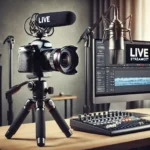Introduction
Live streaming sports events has become a powerful strategy for engaging fans, growing your brand, and generating revenue. With the rise of accessible streaming platforms and a growing thirst for live content, broadcasters and event organizers are seeking ways to optimize their setup. To succeed, you need a deep understanding of Monetization & Growth and a playbook of Troubleshooting & Best Practices.
Common Challenges in Sports Event Live Streaming
Before diving into strategy, it’s important to understand the key challenges involved in broadcasting a live sports event:
- Unstable internet connections can lead to dropped streams or poor video quality.
- Audio-visual syncing issues diminish the viewing experience.
- Monetization barriers may prevent you from profiting effectively from your content.
- High competition makes it tough to stand out without a clear growth strategy.
Without proper planning and execution, you risk damaging your brand’s credibility and disappointing your audience.
Actionable Steps to Master Live Sports Streaming
Below are strategic and practical steps to ensure a successful, profitable, and seamless live sports broadcast. These also align with best practices for Monetization & Growth and efficient Troubleshooting.
1. Invest in Quality Equipment
Great production starts with the right gear. At minimum, you’ll need:
- High-definition cameras (DSLRs or professional camcorders)
- Tripods and gimbals for stabilization
- External microphones for clear commentary
- An encoder (hardware or software)
Ensure your gear supports 1080p streaming and has backup battery solutions. Quality equipment enhances user experience and builds loyalty.
2. Secure a Reliable, High-Speed Internet Connection
A steady upload speed of at least 5 Mbps is critical for HD live streams. Additionally:
- Use a wired Ethernet connection over Wi-Fi
- Set up a backup 4G/5G hotspot
- Use adaptive bitrate streaming to prevent buffering
Preparing fallbacks in advance is a key livestream troubleshooting tip.
3. Choose the Right Streaming Platform
Consider where your audience spends time and choose a platform accordingly. Top options include:
- YouTube Live (free, scalable, monetizable)
- Facebook Live (ideal for social sharing)
- Twitch (popular among younger sports fans)
- Dedicated platforms like Vimeo OTT or StreamYard for brand control
Many platforms come with in-built monetization tools like ads, pay-per-view, or subscriptions—perfect for long-term growth.
4. Push for Monetization Opportunities
Implement various monetization strategies for immediate and long-term profits:
- Sell access: Offer pay-per-view or subscriptions
- Sponsor integration: Display logos or provide sponsor shout-outs
- Merchandising: Promote team-related merchandise in-stream
- Affiliate partnerships: Promote products relevant to your audience (e.g., gear, services)
Learn how to leverage platform-specific tools to maximize Monetization & Growth.
5. Engage Viewers in Real Time
Make your sports event feel dynamic and interactive:
- Enable live chat and react quickly to comments
- Use on-screen graphics and updates (scores, stats, timers)
- Conduct post-game Q&A sessions or interviews
This not only enhances viewer satisfaction but also increases chances of them returning for future events.
6. Perform a Pre-Event Technical Rehearsal
A dry run reduces the risk of unexpected tech failures. Before going live:
- Test all hardware and internet connections
- Verify streaming software settings (output resolution, audio levels)
- Simulate real-time events to ensure syncing is perfect
Troubleshooting & Best Practices always emphasize being proactive, not reactive.
7. Analyze and Optimize After Each Stream
Post-stream analytics are gold for understanding what worked:
- Monitor viewer retention rates, engagement stats, and monetization performance
- Collect audience feedback through surveys or comments
- Use insights to improve your next event’s reach and profitability
Continual optimization is the cornerstone of sustainable growth.
Benefits of Following Live Streaming Best Practices
Implementing the methods above leads to measurable success:
- Higher viewer retention: Better quality and engagement keep fans tuned in
- Increased revenue: Multiple monetization streams boost profitability
- Scalability: Troubleshooting tactics ensure you’re ready for larger events
- Stronger brand authority: Consistent, high-quality streams position you as a leader
By focusing both on the technical and strategic aspects, you set the stage for long-term Monetization & Growth.
Conclusion
Live streaming a sports event can be a game-changer if approached with the right strategy. From handling tech glitches to optimizing for engagement and monetization, every step enhances your success. Take time to plan ahead, use our Troubleshooting & Best Practices tips, and focus on long-term growth.
Start streaming smarter today—and transform your next sports event into a powerful business asset.
